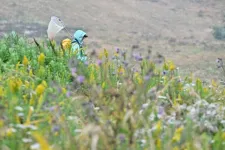(Press-News.org) Images
Much of the nation's stormwater infrastructure, designed decades to a century ago to prevent floods, can exacerbate flooding during the severe weather events that are increasing around the globe, new research led by the University of Michigan demonstrates.
The problem lies in traditional planning's failure to recognize flood connectivity: how surface runoff from driveways, lawns and streets—and the flows in river channels and pipes—are all interlinked. The result is interactions, often unanticipated, between different stormwater systems that can make flooding worse.
"When we design, we typically focus on localized solutions," said Valeriy Ivanov, U-M professor of civil and environmental engineering and co-first author of the study published in Nature Cities. "We have an area of concern, sometimes it's a single plot of land, or a set of parcels that need to be connected by stormwater infrastructure, and we design specifically for those areas.
"But those areas are impacted by flooding that occurs around them, and that means designed stormwater infrastructure may have unintended consequences."
The study is based on record-breaking rainfall that hit Metro Detroit on Aug. 11, 2014, resulting in flooding across the region. The disaster closed highways, stranded drivers, and caused power outages and property damage to over 100,000 homes, with a cost of $1.8 billion. Researchers analyzed data from that event, particularly from the city of Warren, and placed their findings in the context of current U.S. stormwater design standards and flood warning practices to develop policy recommendations.
Those include:
Stormwater system designs should take a holistic, systemwide approach to flood mitigation, rather than the conventional approach focused on local solutions.
Design guidelines for stormwater systems should be revised to consider connectivity in urban landscapes, including flows in subsurface infrastructure such as pipes and sewers, open channel flows such as rivers and streams, and overland flows over natural and built surfaces.
Advanced computer models that represent the full spectrum of stormwater elements and the behavior of water in them should be mandated.
Design scenarios should represent the diverse spectrum of factors that control water flow in urban areas, such as complex rainfall patterns, antecedent soil water conditions, and the operation of existing stormwater drainage systems.
Flood hazard mapping approaches should expand their focus beyond river-adjacent floodplains to include risks in urban areas that may be far from permanent bodies of water.
"Current flood mapping practices are indicative of outdated thinking that needs to change," said Vinh Tran, U-M assistant research scientist in civil and environmental engineering and co-first author. "Whether it's the Federal Emergency Management Agency or someone else producing it, they only provide estimates for floodplains that are near rivers. But here's the problem: In cities, flooding can happen far from any river or stream.
"Take Warren, Michigan, for example. The official flood maps didn't show flood risks in parts of the city that were miles from any major waterway. And it's not just Warren—this is typical all over the country."
According to FEMA, flooding is "the most common and costly disaster in the U.S." That risk is increasing due to climate change.
Financially, it's a problem. FEMA notes that between 1980 and 2000, FEMA's National Flood Insurance Program paid out $9.4 billion in insurance claims. Over the following 20-year period, the program paid out $62.2 billion—an increase of over 660%.
"Without updated designs, the economic impact of flooding will only grow, placing a heavier burden on governments and taxpayers," said Jeff Bednar, environmental resources manager for Macomb County and a research contributor on the project. "By investing in resilient infrastructure now, we not only protect our environment but also strengthen the foundation for economic growth."
Other contributors to the research include: G. Aaron Alexander and Daniel Wright of the University of Wisconsin and Jongho Kim of the University of Ulsan in South Korea.
The research was funded by the U.S. National Science Foundation, U.S. Department of Defense, Environmental Protection Agency and National Research Foundation of Korea.
Study: Connectivity in urbanscapes can cause unintended flood impacts from stormwater systems (DOI: 10.1038/s44284-024-00116-7)
END
Traditional infrastructure design often makes extreme flooding events worse
Massive 2014 flooding event in southeast Michigan showed why systems thinking beats local thinking in flood protection
2024-09-04
ELSE PRESS RELEASES FROM THIS DATE:
A new role for intelligent tutors powered by AI in brain surgery?
2024-09-04
Neurosurgery is perhaps one of the most demanding professions in healthcare. Surgeons spend long hours performing operations where expert performance means the difference between a good and bad patient outcome. While operative injuries are rare, when they occur, they can have serious, and lifelong consequences.
Researchers at the Neurosurgical Simulation and Artificial Intelligence Learning Centre at The Neuro (Montreal Neurological Institute-Hospital) of McGill University are striving to improve brain surgery training by designing real-time, intelligent tutors powered by AI. These systems are designed ...
MD Anderson research highlights for September 4, 2024
2024-09-04
HOUSTON ― The University of Texas MD Anderson Cancer Center’s Research Highlights showcases the latest breakthroughs in cancer care, research and prevention. These advances are made possible through seamless collaboration between MD Anderson’s world-leading clinicians and scientists, bringing discoveries from the lab to the clinic and back.
Protein expression atlas covers almost all cancer hallmarks
The Cancer Genome Atlas (TCGA) and Cancer Cell Line Encyclopedia (CCLE) provide DNA and RNA data from approximately 11,000 patient samples across 33 cancer types and 1,000 cancer cell lines, but limited protein information is available. Researchers led by Han Liang, Ph.D., Rehan Akbani, ...
At-risk butterflies more likely to survive with human help
2024-09-04
VANCOUVER, Wash. – Some of the butterflies most in danger of fluttering out of existence fare better when their habitats are actively managed by humans, a recent study found.
A team led by Washington State University researchers Cheryl Schultz and Collin Edwards analyzed data on 114 populations of 31 butterfly species in 10 U.S. states. Scientists have long warned that insect populations worldwide are falling rapidly due to the combined effects of climate change, habitat loss and pesticides. Overall, the research team found that these at-risk butterflies ...
National Cleveland Clinic survey examines generational divide in men's health
2024-09-04
Embargoed until 12:01 a.m. Wednesday, September 4, 2024, CLEVELAND: A new national survey by Cleveland Clinic revealed similarities and differences across generations when it comes to men’s health. The survey highlights health priorities and concerns among men; however, there were generational differences in health habits, mental health and the use of social media as a source of health information.
While 95% of men surveyed said living a healthy lifestyle is their top priority, findings show that different health behaviors exist among ...
Sex and size disparities in access to liver transplant for patients with hepatocellular carcinoma
2024-09-04
About The Study: In this study, women with hepatocellular carcinoma were less likely to receive a deceased-donor liver transplant and more likely to die while wait-listed than men with hepatocellular carcinoma; these differences were largely (but not entirely) explained by sex-based differences in candidate size. For candidates listed with exception scores, additional changes to allocation policy are needed to resolve the sex disparity, including solutions to improve access to size-matched donor livers for smaller candidates.
Corresponding Author: To ...
The world's first nuclear clock
2024-09-04
For many years, scientists all around the world have been working towards this goal, now suddenly things are happening very fast: it was only in April that a team led by Prof Thorsten Schumm (TU Wien, Vienna) announced a major success. For the first time, an atomic nucleus had been switched from one state to another using a laser – an effect that can be used for high-precision measurements. Now, just a few weeks later, this thorium transition was successfully applied in practice: TU Wien and JILA/NIST (USA) succeeded in combining a high-precision optical atomic clock with ...
H5 influenza vaccines: what needs to be done to reduce the risk of a pandemic
2024-09-04
WASHINGTON — As the global threat of H5N1 influenza looms with outbreaks across species and continents including the U.S., three international vaccine and public health experts say it is time to fully resource and support a robust strategy to address this and future potential pandemic influenza threats, including to consider voluntary vaccination for those now at exposure risk.
“At this critical juncture, decisions about vaccine development, stockpiling, and deployment will shape our ability to respond to immediate and future pandemic risks,” write Jesse Goodman, MD, PhD; Rick A. Bright, PhD; and Nicole Lurie, MD, ...
Epigenetic changes reprogram astrocytes into brain stem cells
2024-09-04
Resting brain stem cells hardly differ from normal astrocytes, which support the nerve cells in the brain. How can almost identical cells perform such different functions? The key lies in the methylation of their genetic material, which endowes these special astrocytes with stem cell properties. Scientists from the German Cancer Research Center (DKFZ) and Heidelberg University have published their findings in the journal Nature. In mice, the researchers showed that experimentally induced lack of blood ...
Sex hormones modulate the immune system to influence disease risk differently
2024-09-04
Researchers have uncovered how hormones profoundly affect our immune systems, explaining why men and women are affected by diseases differently.
Scientists from the Karolinska Institutet in Sweden and Imperial College London have shown for the first time which aspects of our immune systems are regulated by sex hormones, and the impacts this has on disease risk and health outcomes in males and females.
It is well established that diseases can affect men and women differently, due to subtle differences ...
Researchers identify mechanism underlying allergic itching, and show it can be blocked
2024-09-04
Why do some people feel itchy after a mosquito bite or exposure to an allergen like dust or pollen, while others do not? A new study has pinpointed the reason for these differences, finding the pathway by which immune and nerve cells interact and lead to itching. The researchers, led by allergy and immunology specialists at Massachusetts General Hospital, a founding member of the Mass General Brigham healthcare system, then blocked this pathway in preclinical studies, suggesting a new treatment approach for allergies. The findings are published in Nature.
“Our research provides ...
LAST 30 PRESS RELEASES:
Low daily alcohol intake linked to 50% heightened mouth cancer risk in India
American Meteorological Society announces Rick Spinrad as 2026 President-Elect
Biomass-based carbon capture spotlighted in newly released global climate webinar recording
Illuminating invisible nano pollutants: advanced bioimaging tracks the full journey of emerging nanoscale contaminants in living systems
How does age affect recovery from spinal cord injury?
Novel AI tool offers prognosis for patients with head and neck cancer
Fathers’ microplastic exposure tied to their children’s metabolic problems
Research validates laboratory model for studying high-grade serous ovarian cancer
SIR 2026 delivers transformative breakthroughs in minimally invasive medicine to improve patient care
Stem Cell Reports most downloaded papers of 2025 highlight the breadth and impact of stem cell research
Oxford-led study estimates NHS spends around 3% of its primary and secondary care budget on the health impacts of heat and cold in England
A researcher’s long quest leads to a smart composite breakthrough
Urban wild bees act as “microbial sensors” of city health.
New study finds where you live affects recovery after a hip fracture
Forecasting the impact of fully automated vehicle adoption on US road traffic injuries
Alcohol-related hospitalizations from 2016 to 2022
Semaglutide and hospitalizations in patients with obesity and established cardiovascular disease
Researchers ‘listen in’ to embryo-mother interactions during implantation using a culture system replicating the womb lining
How changing your diet could help save the world
How to make AI truly scalable and reliable for real-time traffic assignment?
Beyond fragmented markets: A new framework for efficient and stable ride-pooling
Can shape priors make road perception more reliable for autonomous driving?
AI tracks nearly 100 years of aging research, revealing key trends and gaps
Innovative techniques enable Italy’s first imaging of individual trapped atoms
KIER successfully develops Korea-made “calibration thermoelectric module” for measuring thermoelectric device performance
Diversifying US Midwest farming for stability and resilience
Emphasizing immigrants’ deservingness shifts attitudes
Japanese eels, climate change, and river temperature
Pusan National University researchers discover faster, smarter heat treatment for lightweight magnesium metals
China’s 2024 Gastroenterology Report: marked progress in endoscopy quality and disease management
[Press-News.org] Traditional infrastructure design often makes extreme flooding events worseMassive 2014 flooding event in southeast Michigan showed why systems thinking beats local thinking in flood protection


